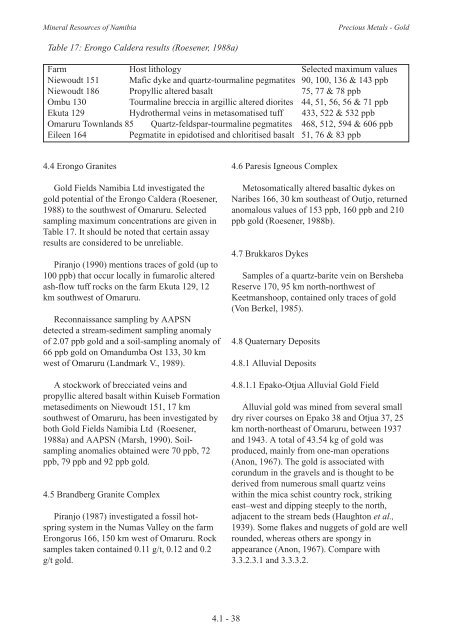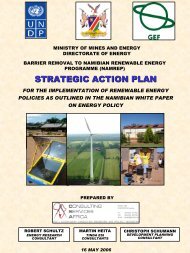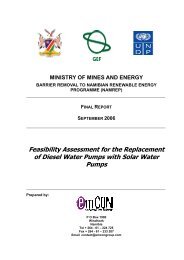Gold Chapter (855 KB) - Ministry of Mines and Energy
Gold Chapter (855 KB) - Ministry of Mines and Energy
Gold Chapter (855 KB) - Ministry of Mines and Energy
You also want an ePaper? Increase the reach of your titles
YUMPU automatically turns print PDFs into web optimized ePapers that Google loves.
Mineral Resources <strong>of</strong> Namibia Precious Metals - <strong>Gold</strong><br />
Table 17: Erongo Caldera results (Roesener, 1988a)<br />
Farm Host lithology Selected maximum values<br />
Niewoudt 151 Mafic dyke <strong>and</strong> quartz-tourmaline pegmatites 90, 100, 136 & 143 ppb<br />
Niewoudt 186 Propyllic altered basalt 75, 77 & 78 ppb<br />
Ombu 130 Tourmaline breccia in argillic altered diorites 44, 51, 56, 56 & 71 ppb<br />
Ekuta 129 Hydrothermal veins in metasomatised tuff 433, 522 & 532 ppb<br />
Omaruru Townl<strong>and</strong>s 85 Quartz-feldspar-tourmaline pegmatites 468, 512, 594 & 606 ppb<br />
Eileen 164 Pegmatite in epidotised <strong>and</strong> chloritised basalt 51, 76 & 83 ppb<br />
4.4 Erongo Granites<br />
<strong>Gold</strong> Fields Namibia Ltd investigated the<br />
gold potential <strong>of</strong> the Erongo Caldera (Roesener,<br />
1988) to the southwest <strong>of</strong> Omaruru. Selected<br />
sampling maximum concentrations are given in<br />
Table 17. It should be noted that certain assay<br />
results are considered to be unreliable.<br />
Piranjo (1990) mentions traces <strong>of</strong> gold (up to<br />
100 ppb) that occur locally in fumarolic altered<br />
ash-flow tuff rocks on the farm Ekuta 129, 12<br />
km southwest <strong>of</strong> Omaruru.<br />
Reconnaissance sampling by AAPSN<br />
detected a stream-sediment sampling anomaly<br />
<strong>of</strong> 2.07 ppb gold <strong>and</strong> a soil-sampling anomaly <strong>of</strong><br />
66 ppb gold on Om<strong>and</strong>umba Ost 133, 30 km<br />
west <strong>of</strong> Omaruru (L<strong>and</strong>mark V., 1989).<br />
A stockwork <strong>of</strong> brecciated veins <strong>and</strong><br />
propyllic altered basalt within Kuiseb Formation<br />
metasediments on Niewoudt 151, 17 km<br />
southwest <strong>of</strong> Omaruru, has been investigated by<br />
both <strong>Gold</strong> Fields Namibia Ltd (Roesener,<br />
1988a) <strong>and</strong> AAPSN (Marsh, 1990). Soilsampling<br />
anomalies obtained were 70 ppb, 72<br />
ppb, 79 ppb <strong>and</strong> 92 ppb gold.<br />
4.5 Br<strong>and</strong>berg Granite Complex<br />
Piranjo (1987) investigated a fossil hotspring<br />
system in the Numas Valley on the farm<br />
Erongorus 166, 150 km west <strong>of</strong> Omaruru. Rock<br />
samples taken contained 0.11 g/t, 0.12 <strong>and</strong> 0.2<br />
g/t gold.<br />
4.1 - 38<br />
4.6 Paresis Igneous Complex<br />
Metosomatically altered basaltic dykes on<br />
Naribes 166, 30 km southeast <strong>of</strong> Outjo, returned<br />
anomalous values <strong>of</strong> 153 ppb, 160 ppb <strong>and</strong> 210<br />
ppb gold (Roesener, 1988b).<br />
4.7 Brukkaros Dykes<br />
Samples <strong>of</strong> a quartz-barite vein on Bersheba<br />
Reserve 170, 95 km north-northwest <strong>of</strong><br />
Keetmanshoop, contained only traces <strong>of</strong> gold<br />
(Von Berkel, 1985).<br />
4.8 Quaternary Deposits<br />
4.8.1 Alluvial Deposits<br />
4.8.1.1 Epako-Otjua Alluvial <strong>Gold</strong> Field<br />
Alluvial gold was mined from several small<br />
dry river courses on Epako 38 <strong>and</strong> Otjua 37, 25<br />
km north-northeast <strong>of</strong> Omaruru, between 1937<br />
<strong>and</strong> 1943. A total <strong>of</strong> 43.54 kg <strong>of</strong> gold was<br />
produced, mainly from one-man operations<br />
(Anon, 1967). The gold is associated with<br />
corundum in the gravels <strong>and</strong> is thought to be<br />
derived from numerous small quartz veins<br />
within the mica schist country rock, striking<br />
east–west <strong>and</strong> dipping steeply to the north,<br />
adjacent to the stream beds (Haughton et al.,<br />
1939). Some flakes <strong>and</strong> nuggets <strong>of</strong> gold are well<br />
rounded, whereas others are spongy in<br />
appearance (Anon, 1967). Compare with<br />
3.3.2.3.1 <strong>and</strong> 3.3.3.2.




